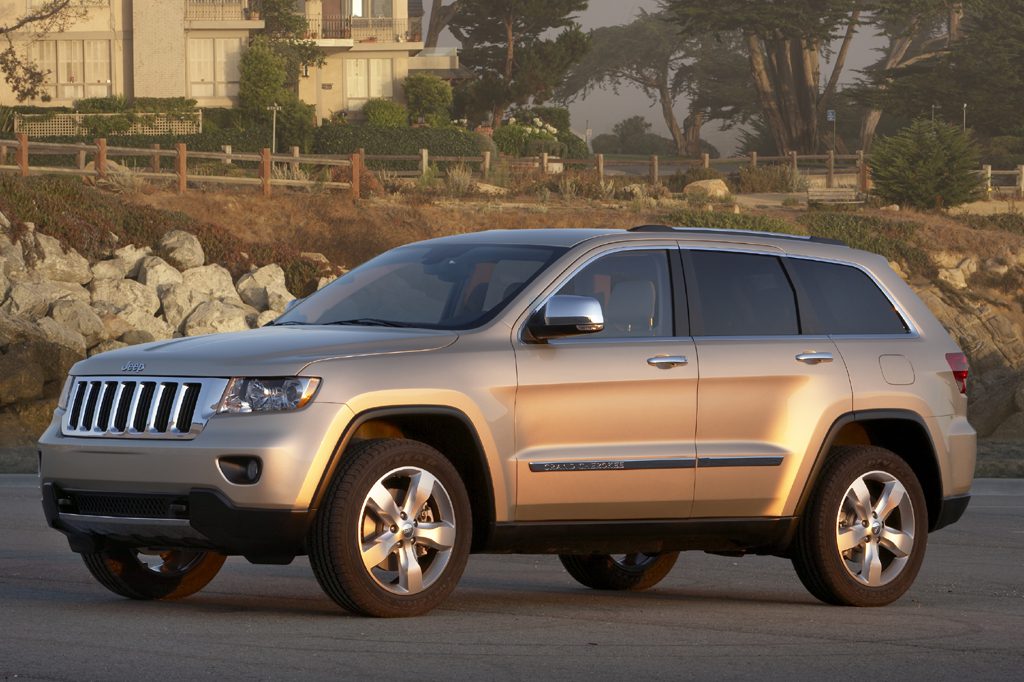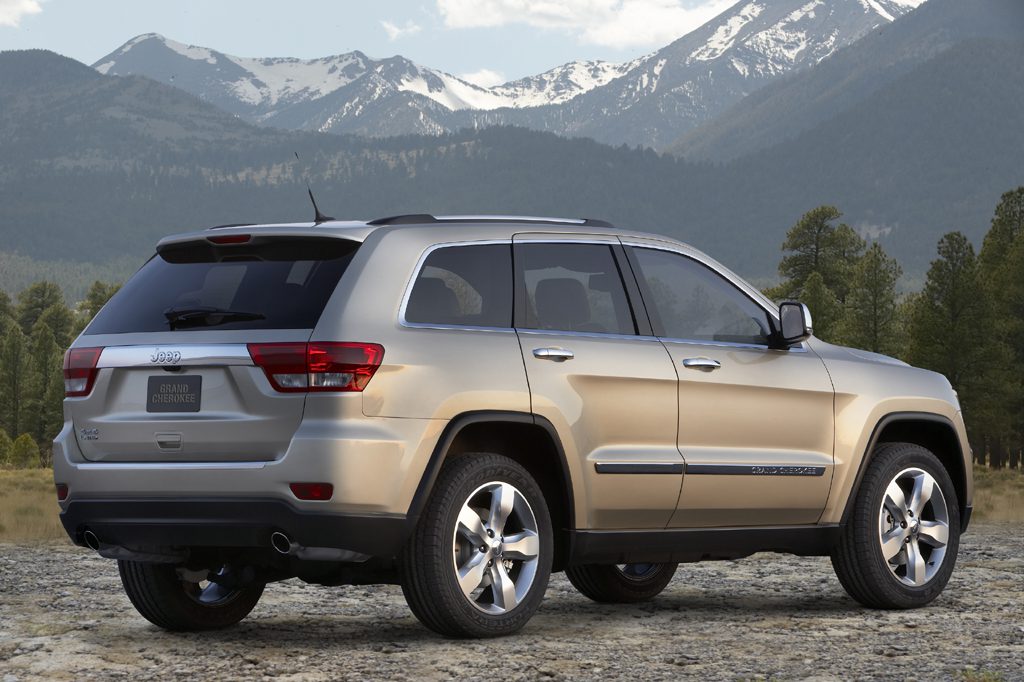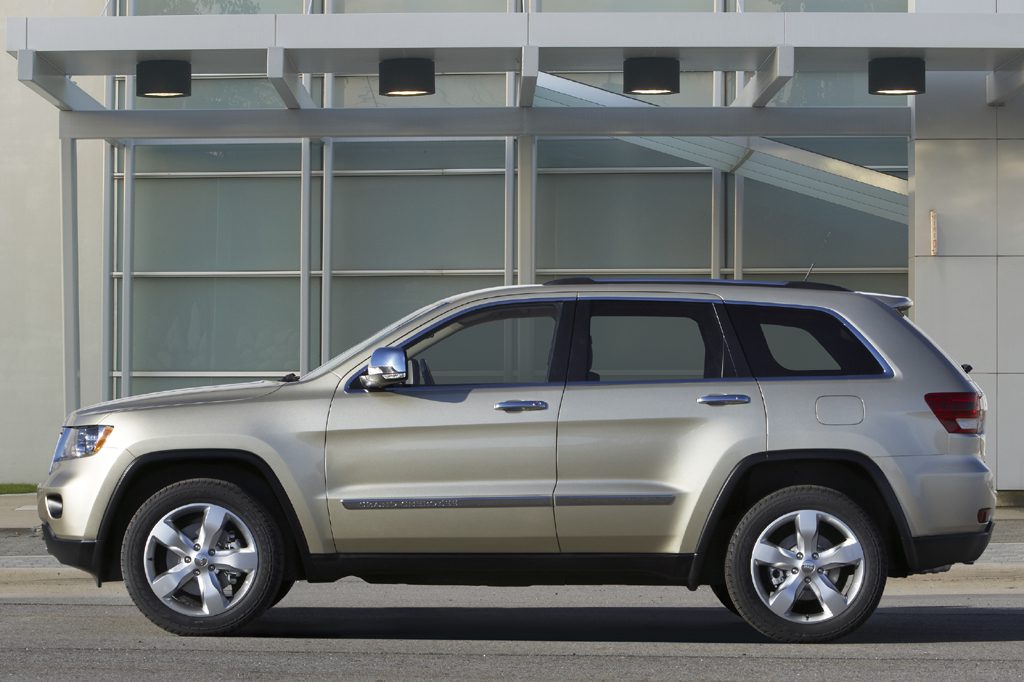| Standard Equipment |
| Laredo : flex-fuel 3.6-liter V6 engine, 5-speed automatic transmission, traction control, dual front airbags, front side airbags, curtain side airbags, antilock 4-wheel disc brakes, antiskid system, hill-ascent control, front-seat active head restraints, tire-pressure monitor, air conditioning w/dual-zone manual climate controls, interior air filter, tilt/telescopic leather-wrapped steering wheel w/radio controls, cruise control, cloth upholstery, front bucket seats, fold-flat passenger seat, center console, split folding rear seat, heated power mirrors, power windows, power door locks, remote keyless entry, AM/FM/CD/MP3 player, digital-media player connection, tachometer, variable-intermittent wipers, illuminated visor mirrors, rear defogger, rear wiper/washer, floormats, automatic headlights, theft-deterrent system, rear privacy glass, rear spoiler, fog lights, rear tow hook, trailer sway control, 245/70R17 on/off-road tires, alloy wheels, AWD adds: all-wheel drive |
| Limited adds: rear-obstacle-detection system, daytime running lights, navigation system w/traffic information, dual-zone automatic climate controls, leather upholstery, heated front and rear seats, memory system (driver seat, mirrors), 8-way power front seats w/lumbar adjustment, mirror-mounted turn signals, keyless access and starting, panoramic power sunroof, satellite radio, USB port, music hard drive, wireless cell-phone link, voice recognition, rearview camera, automatic day/night driver-side and rearview mirrors, universal garage door opener, remote engine start, 115-volt power outlet, rain-sensing wipers, cargo cover, self-dimming headlights, roof rails, bi-xenon headlights, 265/60R18 on/off-road tires, polished alloy wheels, AWD adds: all-wheel drive, 2-speed transfer case, hill descent control |
| Overland adds: rear limited-slip differential, heated wood/leather-wrapped steering wheel, heated/ventilated front seats, power liftgate, Quadra-Lift height-adjustable and load-leveling suspension, full-size spare tire, 265/50R20 tires, alloy wheels, (Deletes polished alloy wheels), AWD adds: all-wheel drive, 2-speed transfer case, hill descent control |
| SRT8 adds: 6.4-liter V8 engine, all-wheel drive, uprated brakes, blind-spot alert, cross-path detection, forward-collision warning, power tilt/telescopic heated leather-wrapped steering wheel, adaptive cruise control, leather/synthetic-suede upholstery, carbon-fiber interior trim, sport suspension w/adaptive damping, 295/45ZR20 run-flat tires, (Deletes panoramic power sunroof, full-size spare tire, Quadra-Lift height-adjustable and load-leveling suspension) |
| Optional Equipment |
| Option Note: |
| Major Packages |
| Option |
Avail. |
Retail |
Dealer |
| E Group |
Laredo |
$1700 |
$822 |
| 8-way power drive seat w/lumbar adjustment, keyless access and starting, satellite radio, roof rails. |
| Quick Order Pkg. 24/26X |
Laredo |
5500 |
4895 |
| Rear-obstacle-detection system, dual-zone automatic climate controls, leather upholstery, heated front seats, 8-way power passenger seat w/lumbar adjustment, rearview camera, remote engine start, upgraded sound system, USB port, music hard drive, wireless cell-phone link, voice recognition, universal garage door opener, automatic day/night rearview mirror, upgraded instrument panel, 115-volt power outlet, cargo cover, alarm, 265/60R18 on/off-road tires. Requires E Group. |
| Altitude Quick Order Pkg. 24/26Z |
Laredo |
6800 |
6052 |
| Rear-obstacle-detection system, dual-zone automatic climate controls, leather upholstery, heated front seats 8-way power passenger seat w/lumbar adjustment, rearview camera, upgraded sound system, music hard drive, USB port, wireless cell-phone link, voice recognition, universal garage door opener, automatic day/night rearview mirror, remote engine start, 115-volt power outlet, cargo cover, unique interior and exterior trim, alarm, 265/50R20 tires. Requires E Group. |
| Trailhawk Quick Order Pkg. 24/26C |
AWD Laredo |
10800 |
9612 |
| Quadra-Trac II, 2-speed transfer case, Selec-Terrain system, hill-descent control, rear-obstacle-detection system, dual-zone automatic climate controls, leather upholstery, heated front seats 8-way power passenger seat w/lumbar adjustment, rearview camera, upgraded sound system, music hard drive, USB port, wireless cell-phone link, voice recognition, universal garage door opener, automatic day/night rearview mirror, remote engine start, 115-volt power outlet, cargo cover, rubber floormats, unique interior and exterior trim, alarm, front tow hooks, rock rails, skid plates, Quadra-Lift height-adjustable and load-leveling suspension, full-size spare tire, 265/60R18 all-terrain tires. Requires E Group. |
| Summit Quick Order Pkg. 24/26R |
Overland |
4000 |
3560 |
| Blind-spot alert, cross-traffic alert, forward-collision warning, front-obstacle-detection system, power tilt/telescopic steering wheel, 2-tone leather upholstery, wood interior trim, adaptive cruise control, power-folding mirrors, unique interior and exterior trim, headlight washers, front tow hooks, polished alloy wheels. |
| Alpine/Vapor Quick Order Pkg. 29M/V |
SRT8 |
2495 |
2221 |
| Adaptive cruise control, unique exterior trim, forged alloy wheels |
| Luxury Group II |
Limited |
1395 |
1242 |
| Heated steering wheel, heated/ventilated front seats, power liftgate. |
| Security and Convenience Group |
Laredo |
995 |
886 |
| USB port, music hard drive, wireless cell-phone link, voice recognition, remote engine start, universal garage door opener, automatic day/night rearview mirror, 115-volt power outlet, cargo cover, alarm. Requires E Group. |
| Off-Road Adventure Group I |
AWD Laredo |
950 |
846 |
| Quadra-Trac II, 2-speed transfer case, Selec-Terrain System, hill descent control, skid plates, front tow hooks, full-size spare tire, 245/70R17 on/off-road white-letter tires. |
| Off-Road Adventure Group I |
AWD Limited |
550 |
490 |
| Skid plates, front tow hooks, full-size spare tire, 265/60R18 on/off-road white-letter tires. |
| Off-Road Adventure Group II |
AWD Limited |
1395 |
1242 |
| Off-Road Adventure Group II |
AWD Overland |
275 |
245 |
| Heavy-duty engine cooling, skid plates, front tow hooks, Class IV receiver hitch, 7-pin to 4-pin wiring harness, Quadra-Lift height-adjustable and load-leveling suspension, full-size spare tire, 265/60R18 on/off-road white-letter tires. |
| 20-Inch Wheel and Nav Group |
Laredo |
2795 |
2488 |
| Navigation system, traffic information, music hard drive, 265/50R20 tires, polished alloy wheels. Laredo requires E Group. |
| All Weather Capability Group |
AWD Laredo |
795 |
708 |
| All Weather Capability Group |
AWD Laredo w/Security and Convenience Group |
595 |
530 |
| Quadra-Trac II, 2-speed transfer case, Selec-Terrain System, hill-descent control, daytime running lights, remote engine start, cargo mat, rubber floormats, engine-block heater, front tow hooks. NA w/5.7-liter V8 engine. |
| Mopar Chrome Edition Group |
Laredo, Limited, Overland |
995 |
886 |
| Chrome exterior trim, door sills, chrome side steps. |
| Trailer Tow Group |
|
595 |
530 |
| Trailer Tow Group |
w/Off-Road Adventure Group I/II |
445 |
396 |
| Class IV trailer hitch receiver, heavy-duty engine cooling, 7-pin to 4-pin wiring harness, load-leveling suspension, full-size spare tire. NA w/5.7-liter V8 engine. NA SRT8. |
| Trailer Tow Group IV |
Laredo, Limited |
695 |
619 |
| Class IV receiver hitch, heavy-duty engine cooling, 7-wire harness to 4-pin wiring harness, load-leveling suspension (Laredo, Limited), full-size spare tire. Requires 5.7-liter V8 engine. Laredo requires Quick Order Pkg. 24/26X. Std. Overland. |
| Trailer Group IV |
SRT8 |
995 |
880 |
| Class IV trailer hitch, 7-wire harness to 4-pin wiring harness, full-size spare tire. |
| Powertrain |
| Option |
Avail. |
Retail |
Dealer |
| 5.7-liter Hemi V8 engine w/cylinder deactivation |
Laredo, 2WD Limited, 2WD Overland |
1695 |
1509 |
| 5.7-liter Hemi V8 engine w/cylinder deactivation |
AWD Laredo w/ Trailhawk Pkg., AWD Limited, AWD Overland |
2195 |
1954 |
| Includes 6-speed automatic transmission. Laredo requires a Quick Order Pkg. |
| Comfort & Convenience Features |
| Option |
Avail. |
Retail |
Dealer |
| Navigation system |
Laredo |
495 |
441 |
| Navigation system |
Limited |
565 |
503 |
| Includes traffic information. Laredo requires a Quick Order Pkg. |
| Uconnect |
Laredo |
495 |
441 |
| Uconnect |
Laredo w/E Group |
410 |
365 |
| Wireless cell-phone link, voice recognition, USB port, satellite radio, automatic day/night rearview mirror. |
| Upgraded sound system |
SRT8 |
1995 |
1776 |
| Power sunroof |
Laredo |
895 |
797 |
| Power sunroof |
Limited (credit) |
-500 |
-445 |
| Laredo requires E Group. Limited substitutes power sunroof for panoramic power sunroof. |
| Panoramic power sunroof |
Laredo, SRT8 |
1395 |
1242 |
| Laredo requires a Quick Order Pkg. |
| DVD entertainment system |
Limited, Overland |
1395 |
1242 |
| DVD entertainment system |
SRT8 |
2540 |
2261 |
| Limited, Overland replace panoramic power sunroof w/power sunroof. SRT8 includes power sunroof. NA w/panoramic power sunroof. |
| Adaptive cruise control |
Limited, Overland |
1495 |
1331 |
| Includes blind-spot alert, cross-path detection, forward-collision warning, automatic day/night passenger-side mirror. Limited requires Luxury Group II. |
| 2-tone leather upholstery |
Overland |
275 |
245 |
| Power liftgate |
Laredo |
495 |
441 |
| Requires a Quick Order Pkg. Requires power sunroof. NA w/panoramic power sunroof. |
| Appearance and Miscellaneous |
| Option |
Avail. |
Retail |
Dealer |
| Engine-block heater |
|
95 |
85 |
| Special Purpose, Wheels and Tires |
| Option |
Avail. |
Retail |
Dealer |
| 265/60R18 on/off-road white-letter tires |
Laredo |
145 |
129 |
| Requires Quick Order Pkg. 24/26X. |
| 265/50R20 tires |
Limited |
795 |
708 |
| 295/45ZR20 performance tires |
SRT8 |
895 |
797 |
| Polished alloy wheels |
2WD Laredo |
995 |
886 |
| Includes 265/60R18 on/off-road white-letter tires. Requires Quick Order Pkg. 24/26X |




